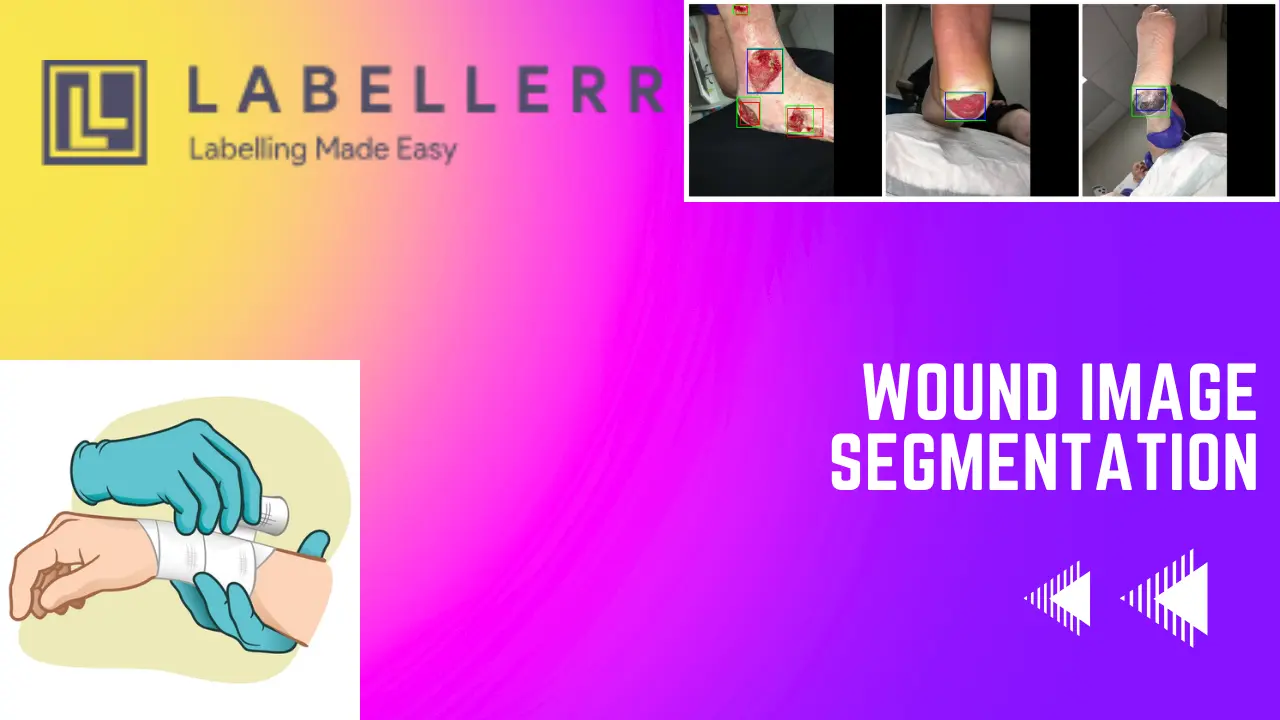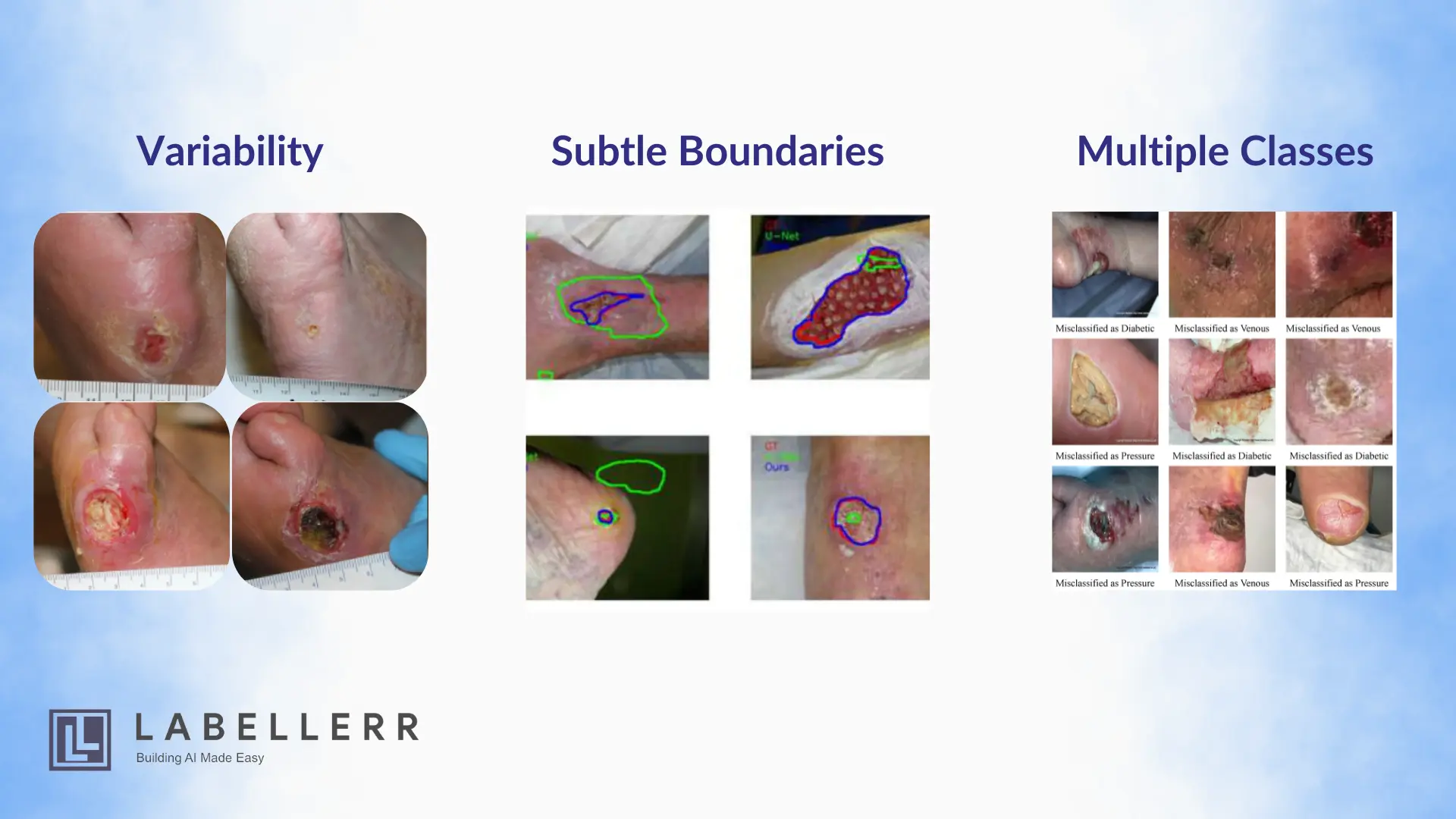Enhancing Wound Image Segmentation with Labellerr

In the United States, around 2.5% of the population suffers from chronic wounds that affect their quality of life and managing wounds has a major financial impact on health care.
Wound segmentation using computer vision technology has emerged as a valuable tool in medical imaging for precise diagnosis and treatment planning.
Accurate segmentation of wounds from medical images, such as photographs or scans, enables healthcare professionals to assess the size, shape, and severity of wounds with greater precision.
This information plays a crucial role in determining appropriate treatment strategies and monitoring wound healing progress over time.
However, manual segmentation of wounds from medical images is a labor-intensive and time-consuming task, prone to subjectivity and variability among annotators.
To address these challenges, the integration of Labellerr, a leading data annotation platform, offers a solution for automating and standardizing the annotation process.
By leveraging Labellerr's advanced annotation tools and robust segmentation features, healthcare professionals can streamline the annotation of wound images, enhancing efficiency and accuracy in wound segmentation tasks.
With Labellerr’s annotation platform, Automate and standardize wound segmentation tasks to save time, reduce costs, and boost accuracy. Sign up for a free trial.
Table of Contents
Challenge
The process of defining the wound area in an image, known as wound image segmentation, poses a number of challenges for human annotators that affect the precision and effectiveness of the annotation process. Let us discuss a thorough explanation of these challenges:
Characteristics of the Wound

Characteristics of Wound
Variability: There are differences in the sizes, forms, textures, and colors of wounds. Because of this variation, it is challenging to develop a segmentation strategy that works for all images; instead, each image needs to be carefully considered.
Subtle Boundaries: There may occasionally be unclear or poorly defined boundaries separating the healthy tissue that surrounds the wound bed, which causes uncertainty and inconsistent annotation.
Existence of Multiple Classes: Advanced annotation may be necessary for advanced segmentation if it is necessary to annotate other wound sub-regions (such as granulation tissue, slough, and eschar) in addition to the main wound boundary.
Solution:
Standardized Hierarchy of Annotations: Establish a uniform hierarchy for wound segmentation that divides complex wounds into more manageable, smaller sub-regions that have explicit definitions. This makes it possible to segment various wound characteristics consistently.
Problems with Image Quality:
Low Resolution: It may be challenging to identify wound margins and wound tissue from other objects, such as scabs or dressings, in photos that are blurry or grainy. In these situations, annotators might have to depend on contextual signals.
Variations in Lighting: The way a wound appears can be greatly impacted by lighting. It can be difficult to distinguish wound boundaries precisely when there are shadows, bright patches, or uneven illumination.
The presence of medical equipment in an image, such as bandages or drainage tubes, might obscure sections of the wound and necessitate careful segmentation.
Solution
Techniques for Pre-processing and Enhancing Images: To increase image quality prior to segmentation, apply image pre-processing techniques such as sharpening, contrast improvement, and noise reduction. In low-resolution or unevenly-lit images, this can assist clarify tiny boundaries and improve the visualization of wound edges.
Subjectivity and Annotator Variability:
Training and Experience: Annotator training and experience levels can have an impact on annotation accuracy. To reduce inconsistencies, standardized policies and training methods are essential.
Inter-annotator Variability: Despite training, there may still be some variation in the annotations between annotators' assessments of wound boundaries.
Solution
Consensus labeling and active learning: Make use of active learning, in which the model prioritizes the annotation of unclear areas in images.
Furthermore, employ a consensus labeling strategy in which the borders of a image are finalized by a majority vote or conflict resolution procedures after several skilled annotators have segmented the image.
As a result, consistency is increased and the influence of personal interpretation is reduced.
These challenges present the need for advanced segmentation algorithms and automated annotation tools, such as those provided by Labellerr, to improve the efficiency and accuracy of wound segmentation in medical imaging.
Solution Using Labellerr for Wound Image Segmentation

Want to see Labellerr in action? Check out this video to explore how our platform enhances wound image segmentation
Intuitive Interface
Labellerr offers an intuitive interface designed to streamline the annotation process for wound segmentation.
With user-friendly tools and clear labeling options, annotators can easily identify and delineate wound regions in medical images.
The intuitive interface minimizes the learning curve, enabling annotators to efficiently annotate wound areas without being hindered by complex annotation tools.
This user-friendly interface enhances productivity and ensures consistency in the segmentation process.
Cost Savings
Labellerr provides significant cost savings for healthcare facilities by optimizing the annotation process for wound segmentation.
By automating repetitive tasks and streamlining workflow management, Labellerr reduces the time and resources required for manual annotation.
This results in cost savings associated with labor expenses and improves the overall efficiency of the wound segmentation process.
Additionally, Labellerr's pay-per-task pricing model ensures cost-effectiveness by allowing healthcare facilities to pay only for the annotations they need.
Robust Segmentation Features
Labellerr incorporates robust segmentation features, including the advanced Segment Anything Model, specifically tailored for wound segmentation tasks.
This model excels at accurately delineating wound boundaries, even in cases of irregular shapes, overlapping tissues, and varying textures.
By leveraging state-of-the-art segmentation algorithms, Labellerr ensures precise and consistent segmentation results, essential for accurate wound assessment and treatment planning.
The robust segmentation capabilities of Labellerr enhance the quality and reliability of annotated data, ultimately improving the performance of wound segmentation models in medical imaging applications.
Active Learning Based Labeling
Labellerr implements active learning techniques to optimize the annotation process for wound segmentation.
By intelligently selecting the most informative image regions for annotation, Labellerr maximizes the efficiency of data labeling, reducing manual effort while improving the performance of trained models.
This active learning-based approach enables annotators to prioritize labeling efforts on areas that are most beneficial for model training, ultimately leading to more accurate and effective wound segmentation models.
Automated Import and Export of Data
Labellerr streamlines the process of importing and exporting data for wound segmentation tasks with its automated functionalities.
Whether integrating data from medical imaging devices, electronic health records, or other sources, Labellerr simplifies the data management process, enabling seamless integration of images into the annotation platform.
Similarly, Labellerr facilitates the export of annotated data, ensuring compatibility with various medical imaging systems and analysis tools for further processing.
Collaborative Annotation Pipeline
Labellerr fosters collaboration among healthcare professionals and annotators with its collaborative annotation pipeline.
Multiple users can work simultaneously on annotating wound images, enabling distributed workflows and real-time collaboration.
This collaborative approach enhances productivity and ensures consistency and accuracy in the labeled dataset, ultimately improving the performance of wound segmentation models.
Additionally, Labellerr's collaborative annotation pipeline facilitates knowledge sharing and expertise exchange among team members, further enhancing the quality and reliability of the annotated data.
Frequently Asked Questions
Q1) What is wound segmentation, and why is it important in medical imaging?
Wound segmentation is the process of identifying and outline the boundaries of wounds in medical images, such as photographs or scans. It is essential in medical imaging for precise diagnosis, treatment planning, and monitoring of wound healing progress.
Q2) How does Labellerr assist in wound segmentation tasks?
Labellerr provides advanced tools and features specifically designed for wound segmentation, including an intuitive interface, robust segmentation algorithms, and active learning-based labeling techniques.
These functionalities streamline the annotation process and improve the efficiency and accuracy of wound segmentation tasks.
References

Simplify Your Data Annotation Workflow With Proven Strategies
.png)


